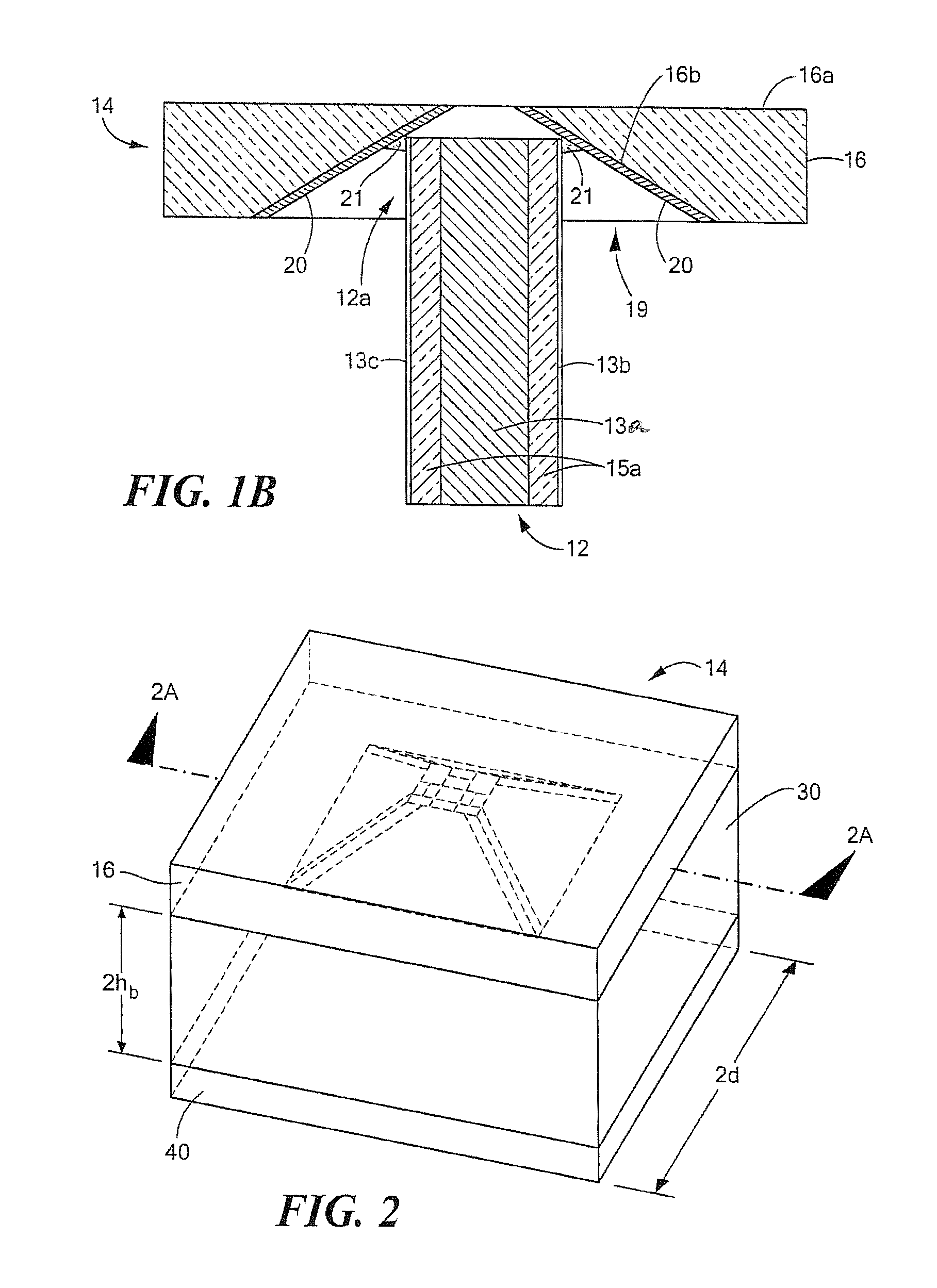[0008]With this particular technique, a vertical
feed line balun is provided. In one embodiment, the conductive member is provided having a square cross-sectional shape and a
microstrip transmission line is disposed over each of the four external surfaces of the square conductive member to provide the balun as a quad vertical
feed line balun made out of four individual transmission lines disposed over a common ground conductor. In one embodiment, the balun is provided as a Dyson balun and is used to feed a radiator such as a droopy bowtie radiator. By using a central conductive member and placing pairs of
microstrip transmission lines on opposing surfaces of the central conductive member, the
microstrip lines are physically and electrically isolated from each other (i.e. the microstrip lines are isolated by air gaps). This provides the balun having a high cross-polarization isolation characteristic. The same quad line can be used for operation in the S-, C-, and X-frequency bands, without changing balun parameters such as the cross-sectional dimensions of the quad vertical feeding line. The balun is mechanically stable which facilitates attachment to a
printed circuit board (PCB) on one end, and to a radiator on the other end. Furthermore, since the quad vertical feeding line is mechanically symmetric, it lends itself to an easier
assembly process than prior art approaches using pick and place equipment. The balun also provides coincident phase centers for orthogonal dipoles as well as flexibility in choosing array lattice geometry (rectangular, triangular, etc.).
[0011]Such a construction provides a balun having a
high isolation characteristic between two
transmission line pairs feeding two antennas. The
high isolation characteristic is a result of the use of a central conductor as well as the use of a
dielectric substrate having a relatively high relative dielectric constant (εr). Furthermore, the transmission lines disposed about the central conductor are isolated by air gaps which also helps to increase the isolation characteristic of the balun.
[0013]In one embodiment, the use of a dielectric material having a 25 mil thickness allows fabrication of a balun having dimensions that can be used in a variety of different frequency ranges (i.e. the same balun dimensions can be used over a wide range of frequencies) and which are very convenient for mechanical
assembly. For example, the same dimensions can be used for baluns operating in the X-band frequency range as well as in the S-band and C-band frequency ranges. Other dielectric material thicknesses, may of course, also be used while also providing the ability to operate over a plurality of different frequency ranges and / or frequency bands. It should, however, be appreciated that the line feed impedance (i.e. the impedance of the quad vertical feeding line) depends, in part, upon the
dielectric thickness and conductor
line width (e.g. for a given
line width, the dielectric material thickness affects the line feed impedance but the feeding line can be used over the S-, C- and X-Bands). In one embodiment, all balun transmission lines have the same
characteristic impedance of about 30 Ohms per port, assuming that opposing ports are fed
out of phase by 180 degrees. This means a 60
Ohm impedance per one
dipole antenna fed with two ports in series, should provide an impedance match to a bowtie radiator which allows desired operation of the integrated balun and bowtie radiator.
[0015]With this particular arrangement, an
integrated antenna-balun combination (also referred to herein as an
integrated antenna element) is provided which allows operation over a relatively wide range of frequencies while at the same time providing a relatively high cross-polarization isolation characteristic.
[0017]In one embodiment, the radiator may be provided using an injection-molding technique and thus the radiator may be provided as a low-cost radiator. Such an element is suitable for use in an array.
[0018]In one embodiment, a quad vertical feeding line made out of four individual transmission lines disposed around a common ground conductor column feeds a radiator. In one embodiment, the ground conductor column is provided as a
solid column having a rectangular or square cross-sectional shape. In some applications, a
solid conductor may be preferred for mechanical purposes, but in other applications, a hollow or partially hollow conductor could also be used. The use of individual transmission lines provides the balun having a relatively high cross-polarization isolation characteristic and is easily manufactured using commercially available materials. The same quad line can be used for S-, C-, and X-band frequency ranges, without changing balun parameters (i.e. without changing the cross-sectional dimensions of the quad vertical feeding line). The balun is mechanically stable which facilitates attachment to a PCB on one end, and to a radiator on the other end. The balun also provides coincident phase centers for orthogonal disposed dipoles, and provides flexibility in choosing an array lattice geometry (rectangular, triangular, etc.).
 Login to View More
Login to View More  Login to View More
Login to View More 


